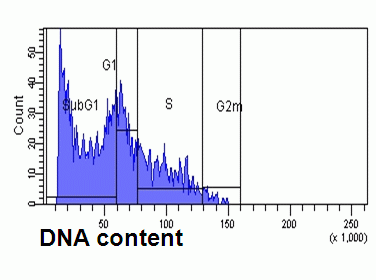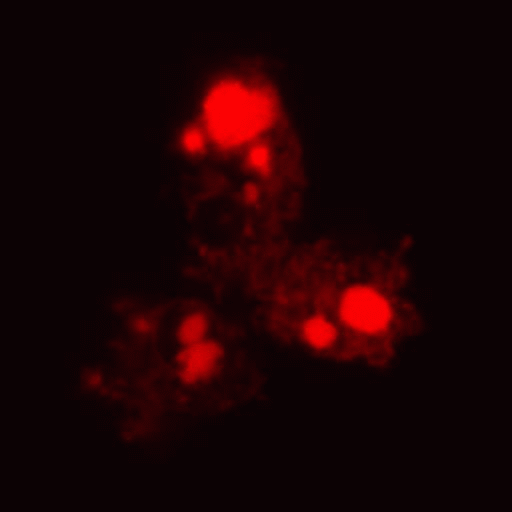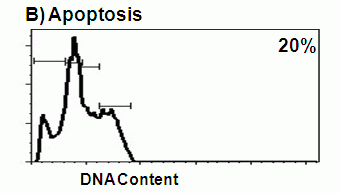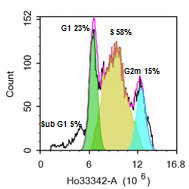There are certain characteristics of apoptotic cells that can be identified and used to detect apoptotic cells in an otherwise healthy population of cells. Technically the easiest characteristic to detect is loss of DNA from permeabilised cells due to DNA fragmentation. When cells are permeabilised, for example by 70% ethanol, the fragmented 182bp DNA multimers leak out of the cell. The result is a population of cells with a reduced DNA content. If the cells are then stained with a DNA intercalating dye like propidium iodide, then a DNA profile representing cells in G1, S-phase and G2M will be observed with apoptotic cells being represented by a sub G0/G1 population seen to the left of the G0/G1 peak.
The advantage of this method is that it is very rapid and will detect cumulative apoptosis and is applicable to all cell types. However in order to be seen in the SubG1 area, a cell must have lost enough DNA to appear there; so if cells enter apoptosis from the S or G2/M phase of the cell cycle or if there is an aneuploid population undergoing apoptosis, they may not appear in the SubG1 peak. Also cells that have lost DNA for any other reason, e.g. death by some other form of oncosis, will appear in the SubG1 region; so we have to be careful about how we define the sub-G1 peak, see figure. As with all methods that are used to detect apoptosis, the more processing steps involved, the greater the likelihood of losing cells and as apoptotic and necrotic cells are sometimes preferentially lost, the fewer manipulations the better.
Etoposide induces apoptosis which results in a S phase cell cycle arrest, while necroptosis induced by Shikonin causes a cell cycle arrest in the G2m phase of the cell cycle, see figure.
An alternative method for detecting DNA fragmentation involves the identification of the nicks (or strand breaks) using the TUNEL technique. The TdT dUTP nick end labelling (TUNEL) technique is based on the ability of terminal deoxynucleotidyl transferase (TdT) to end label nicks in the DNA brought about by the caspase activated deoxyribonuclease with the nucleotide deoxyuridine triphosphate (dUTP). TdT has the ability to label 3' blunt ends of double stranded DNA independently of a template.
The are various techniques to detect the incorporated dUTP. These include using dUTP conjugated with either biotin or digoxygenin. For flow cytometry the former is labelled with FITC avidin and the latter by using FITC conjugated antibody to digoxygenin. Another variation is to use BrdU, as a thymidine analogue which is again visualised using FITC conjugated anti BrdU antibodies. More recently, a direct protocol has been made available by virtue of labelling dUTP with FITC. This eliminates the requirement for secondary reagents and therefore is less labour intensive. Moreover, non specific binding of secondary reagents is eliminated thus maintaining sensitivity. This method remains the method of choice when using TUNEL techniques for flow cytometry. Nicks occur at a far higher rate in apoptosis than necrosis. The DNA may simultaneously be stained with propidium iodide, so it is possible to tell from which phase of the cell cycle the cells are exhibiting strand breaks. A commercially available kit for this purpose - the ApoBrdU kit may be obtained from the Phoenix Flow Systems website [new window].




